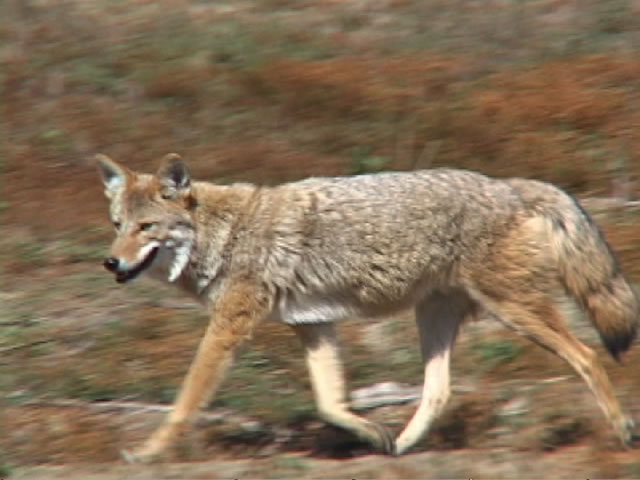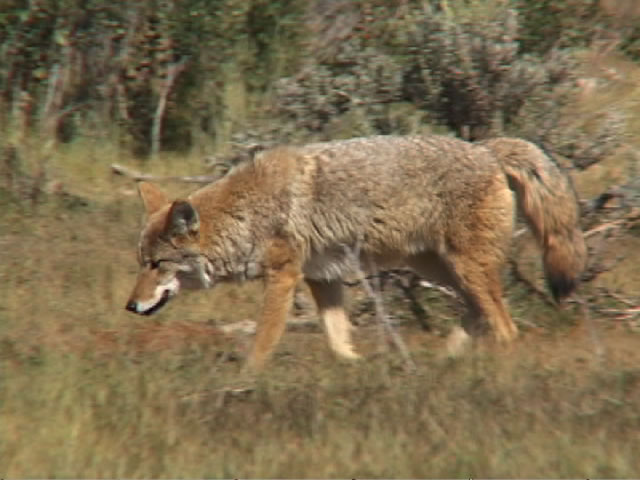Coyotes maybe the species most adept at adapting to changing habitats, climates and human activities. These tricksters thrive where other predators pass away.
One story stands out in my memory. I don’t remember the exact words—they don’t matter—but the story sticks with me:
Long before European settlers touched foot in the Pacific Northwest, back during the earliest days of human on in these lands, the animals helped create the world as it exists today. Coyote was one of the most prominent and wisest of the animals.
One day, during his travels, Coyote heard whispers that the new people of his land were being killed by a great monster in the Columbia River. This monster hid in a deep pool at Wishram (above the present-day sight of The Dalles), where the waters ran swiftly through rock-lined channels. The monster would lurk in its pool and pull down the two-legged people as the paddled their canoes through narrow channels. The people were afraid of the monster and soon began to avoid the river, though this meant they could not catch the salmon that fed their children. More people died as they went hungry because of their fear.
The Coyote had been waiting for these two, two-legged people to come into his land. When he heard the stories of the monster, he was angry and wanted to do something to help the people, but did not know how to defeat a monster that lived in a deep pool in the river. So Coyote went to the mountains and asked his friend, the Raven, how to help the people. Together, Coyote and Raven came up with a plan.
Coyote would gather up a bundle of dry wood, with some pitch-wood mixed in, so he could make a fire. He put five sharp bone knives into his bundle. Coyote then headed down to the river to meet the monster.
Coyote stood on the bank of the deep pole where the monster lived and taunted the beast. At first, the monster wouldn’t eat Coyote because it knew Coyote was a trickster and it was afraid. But Coyote continued to taunt and laugh at the monster, mock it until the beast rose up in anger and swallowed Coyote.
Once inside the monster, Coyote lit his fire and found many people huddle there. All were cold, wet and near death. Coyote threw more wood on his fire to warm the people, and then used the first knife to carve meat from the monster’s heart. This he roasted and fed to the people, making them strong once more.
As the people ate, Coyote used his knife to cut at the cords that held the monster’s heart in place. Soon, Coyote’s knife broke. But Raven had known that the monster’s sinew would be tough and had made Coyote carry five knives. Coyote retrieved his second knife and continued cutting the cords. When it, too, broke, he took up his third, and then his fourth, knife.
Finally with this fifth knife, Coyote had the cords nearly cut through, and the heart ready drop out, killing the monster. Suddenly, the monster coughed and all the people, and coyote were flung onto the river bank.
Coyote gave names to the people he had saved and send them in all directions to occupy the lands. To the north of the river, he sent the Yakamas and the Klickitats, to the south, he sent the Clackamas and Clatsops. The Nez Perce and Cayuse went east, preferring to live among the hills and raise ponies. They also thanked Coyote for his help, praising his intelligence and cleverness in defeating the monster.
Once all the people had been sent to their new homes, Coyote looked the monster in the eye, and said, “You must not eat the people anymore. If you do not swear to let the people use the river and catch the Salmon that feeds them, I will jump into your throat and cut your heart loose.”
The monster promised to let the people pass, but feared that he would die without anything to eat, so Coyote send to him: “You may shake the canoes in the rapid water and eat any of the people who lack the skill to paddle through them. In this way, the people know there is danger, and only those who are careless will feed you.”
The monster agreed and that is why some people still disappear in the rapids at Wishram. So goes the story, though today the rapids are now deep under the reservoir behind the Bonneville Dam. But the monster remains, eating foolish boaters throughout the rivers of the west.
The nature of the wily coyote
I first heard this story from a professor, or maybe it was just a graduate student, in one of my Native American history courses at Washington State University. Later, I heard the same basic story—told in different words and with slightly different context, but with the same general premise—while attending a Native American Pow-Wow at the Puyallup Tribal Grounds near Tacoma. Since then, I’ve seen the story in print in several forms, all slightly different, but each sharing the same basic tenets.
What makes it memorable for me is the fact that Coyote uses his quick-wit and intelligence to help the people of the world. The local tribes revere him for this. Today, though, coyote is reviled for his intelligence and ability to adapt to new situations. The coyote of the 20th century has been stamped as a vile, cowardly beast, and as such, it has been hunted mercilessly for the last hundred years and more throughout the west.
But which is the true nature of the Coyote? Neither, I think.
I believe that the coyote is a species that has never been fully understood by humans, largely because it is malleable and changeable. The coyote will do what is required to adept to any situation it faces. It will change its diet, change its hunting style, and even change its mating practices. The coyote’s most consistence feature is its able to change and adapt.
The trickster. The Wise One. The Monster-fighter. Moon-dog. Ghost dogs. Little Wolf. Sheep-eater. Vermin. Canis lantrans (Latin for ‘barking dog’). The coyote has been label all these and more by the people who know the animal best.
I prefer the Native American labels—the first three being my favorites and, I believe, the most appropriate. Coyotes have been part of the native mythology and oral legends since people first moved onto the continent. Coyotes are native to North America and, though they do seem closely resemble species in other parts of the world—most notably the golden jackal of Africa—they are native only to the western United States and far southern parts of western Canada. Therefore, the American Indians tribes of the American West are the people who best know the crafty canine.
Coyotes—pronounced Ki-Yo-Tees by some, Ki-Oats by others (particularly folks living in rural parts of the west)—are perhaps the most adaptable, versatile predator in North America. They have learned to out-smart hunters and trappers, to avoid poisoned bait, and to take advantage of any opportunity to expand their territory. Coyotes still reside in all their native range—but have also moved into the rainforests of Western Washington. They have spread north to Alaska and south to Panama. They live in the Appalachian and Adirondack Mountains. And, most impressive, they have found good hunting in the urban wildernesses of out major cities. Coyotes roam the streets of Los Angeles, and by the late 1990s coyotes caused a stir in downtown Manhattan—apparently they moved in to hunt the local population of stray dogs, cats and rats (the small, four-legged variety, not the two-legged types in business suits which are more common in that megalopolis).
In Washington state, coyotes are native to the drylands and deserts of the Columbia Basin, and the pine forests and sage brush hills of the Umatilla, Colville, Okanogan and Wenatchee National Forests. They were less common, though not unknown, in the wet forests of western Washington. Today, however, the Washington Department of Fish and Wildlife (WDFW) categorizes every square inch of Washington state at ‘core habitat’ for coyotes. That is, while other predator species declined in population , or outright disappeared, this small canine pushed its range, expanding out into areas previously dominated by wolves, cougars and bears. The coyote now thrives in every county, and in many cities, of Washington, as well as coast to coast, in every state except Hawaii.
Trickster indeed.




















